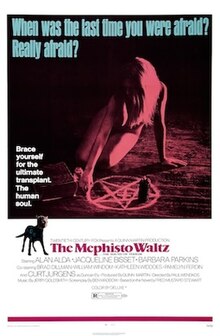|
The Mephisto Waltz
The Mephisto Waltz is a 1971 American supernatural horror film directed by Paul Wendkos and starring Alan Alda, Jacqueline Bisset, Barbara Parkins, Bradford Dillman, and Curt Jürgens. Its plot follows a dying Satanist who attempts to have his soul transferred into the body of a young concert pianist. The name of the film is taken from the piano work of the same title by Franz Liszt. The performance of this work heard in the film is by Jakob Gimpel, although the piece did not appear on the soundtrack album (in this, or any other, performance) when it was released in 1997. Ben Maddow adapted his screenplay from the novel of the same title by Fred Mustard Stewart. The film was the only big-screen work of veteran television producer Quinn Martin. PlotMyles Clarkson, long ago frustrated in his hope for a career as a concert pianist, is now a music journalist and interviews Duncan Ely, perhaps the world's greatest piano virtuoso. At first annoyed by Myles' presence, Duncan notices that Myles' hands seem perfect for the piano. From that point, Duncan and his adult daughter, Roxanne, strongly pursue a friendship with Myles and wife Paula. Paula does not much like Duncan and especially dislikes Roxanne. While Paula is disturbed by the level of attention being paid to them, Myles is honored to be considered a friend by Duncan, who is dying of leukemia. Unbeknownst to them, Duncan and Roxanne are Satanists. As Duncan's physical body nears its end, father and daughter perform an occult ritual that transfers Duncan's consciousness into Myles' body while Myles’ consciousness is transferred into the body of Duncan as he dies. Myles' ensuing change in personality, which includes his now being able to play the piano as well as had Duncan, is noticed by Paula, but she is initially unsuspecting of the cause. Though confused by the change in her husband, she also finds his new persona exciting and attractive. Myles soon is pursuing a career as a pianist and is so successful that he is able to take over Duncan's concert schedule. Paula has a nightmare in which she envisions Duncan telling her that he must kill Abby, her and Myles' young daughter. Duncan tells her that he does not want to harm the girl, but that his Master has insisted upon it as "part of the bargain". Immediately after the dream, in which a blue substance is placed on Abby's forehead, Paula finds the blue substance actually on her daughter's skin. Abby gets ill and dies. Abby's death sparks in Paula a further suspicion of Roxanne. As Myles seems to drift away from her into his new career, Paula investigates Roxanne's background. This includes visiting Roxanne's ex-husband, Bill, and a romantic relationship begins to form between the two. Paula eventually becomes convinced that Duncan and Roxanne struck a deal with Satan to enable them to pursue an incestuous relationship, that they have placed Duncan's consciousness into her husband's body, and that they are responsible for Abby's death. Paula falls asleep and Bill dies in an apparent accident, though he too has the blue substance on his forehead. Paula nearly meets a similar "accidental" fate, which leaves her certain that Roxanne and Duncan (in Myles' body) killed Bill, and fearful that they will try to eliminate her. She resolves that, regardless of who is inhabiting her husband's body, she wants to be with that man. As a result, she turns to Satanism and strikes her own bargain with the Devil. She then attacks Roxanne, knocks her unconscious, and employs the same dark magic that Duncan and Roxanne had used against Myles. Paula transfers her own consciousness into Roxanne's body, leaving her own body dead in the bath, an apparent suicide. In Roxanne's body, Paula returns to Duncan/Myles, who happily informs her of Paula's suicide. Without telling him who she really is, she embraces him, enthralled with the excitement of the beginning of their new relationship. Cast
ProductionExteriors were shot on location along the Pacific coast in California; the book took place in New York City. The film, which was a Quinn Martin Production, was originally given a cinematic release by 20th Century-Fox. ReceptionThe film was noted for its stylistic imagery and soundtrack by Jerry Goldsmith. All Movie Guide noted Alan Alda's performance as the film's only weak point, praising the "offbeat cinematography", "truly shocking setpieces", and Jacqueline Bisset's "chillingly effective" performance, stating that these elements build a pervading sensation of doom.[2] Rotten Tomatoes gives the film a 63% rating based on 8 contemporary and modern reviews.[3] Roger Ebert gave the movie 2 stars, commenting:
SoundtrackVarèse Sarabande issued an album of Jerry Goldsmith's score in 1997, paired with a suite from his score for The Other.
See alsoReferences
Further readingSchreck, Nikolas. The Satanic Screen: An Illustrated Guide to the Devil in Cinema. London: Creation Books, 2001, pp. 156–57. External links |
||||||||||||||||||||||||||||
Portal di Ensiklopedia Dunia
